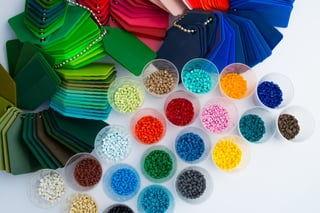Colored plastics are used every day in a huge range of applications and settings, but very few people know — much less stop to consider — how these hues are achieved. With the help of Penn Color, a knowledgeable and experienced local colorant manufacturer who has a longstanding partnership with The Rodon Group, we have gathered information and insights into how the plastic products we know and use every day get their colors.
Plastics can be colored using various coloring systems, each of which offers its own unique properties, benefits, and drawbacks. Masterbatches,”salt and pepper” blends, Liquid Color, and precolored resins are four of the most common coloring techniques.

To color the injection-molded products we produce at The Rodon Group, we purchase “natural” polymers, such as Nylon, LDPE, ABS or Polypropylene, for instance, in pellet form. We then blend color concentrates, many from Penn Color through a dosing unit to dispense the colorant at anywhere from 1% to 4% typically. The dispensing unit is calibrated and then set to provide the exact amount of colorant to color any of the natural polymers we buy.
The Color Matching Process
To pinpoint the desired color for each plastic product or part, a color matching process must be completed, which allows engineers to develop a specific color concentrate for a particular application. Typically, a chip, plaque, or Pantone number provides an approximate idea of the desired hue, and information about the specific polymer being used helps determine the formulation for the color concentrate.
For each polymer being color matched, various factors must be taken into consideration, including viscosity and melt processing temperatures. For example, a laboratory may use formulation guidelines to determine what carrier resins, pigment systems, stabilizers, or other additives would be suitable for the specific product and application at hand, as prescribed on the color match request form. It’s also important to keep in mind that colors will look different depending on the polymers’ gloss, appearance, and filler content; a color in nylon is going to look different from the same color in acrylic, for example. Environmental conditions, chemical resistance, and FDA suitability must all be taken into consideration when preparing a color match.
Penn Color can color match in any polymer system, some of which include nylon, polypropylene, polyethylene, polyesters, PVC, and acrylics. A color spectrophotometer is used to measure, store, and formulate colors using a computer color matching system. All colors and polymer systems are stored electronically in the color matching system — as well as in chip files or plaques produced in a laboratory during the color matching process.
Source Destination:
https://info.rodongroup.com/how-plastic-resins-get-their-color




